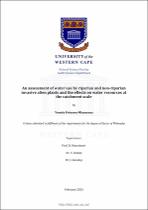| dc.contributor.advisor | Mazvimavi, Dominic | |
| dc.contributor.author | Mkunyana, Yonela Princess | |
| dc.date.accessioned | 2023-08-14T10:38:53Z | |
| dc.date.available | 2023-08-14T10:38:53Z | |
| dc.date.issued | 2023 | |
| dc.identifier.uri | http://hdl.handle.net/11394/10485 | |
| dc.description | Philosophiae Doctor - PhD | en_US |
| dc.description.abstract | The diversity and increasing extent of invasive alien plants (IAPs) are currently a global ecological and economic problem, especially in semi-arid regions. The introduction of IAPs worsens the strain in South Africa’s water resources by reducing the mean annual runoff by approximately 7%. Further work needs to be done to ensure that those IAPs that have the greatest impact receive priority. Effective management of IAPs promotes the conservation and sustainable use of the natural environment, the economies it supports, and the high quality of life in society. The monitoring of the distribution of IAPs is therefore an important consideration in catchment management. Remote sensing and cloud computing platform, Google Earth Engine (GEE) were used to map land use/landcover changes between the 1973 – 2021 period using Landsat imagery. | en_US |
| dc.language.iso | en | en_US |
| dc.publisher | University of the Western Cape | en_US |
| dc.subject | Actual evapotranspiration | en_US |
| dc.subject | Alien clearing | en_US |
| dc.subject | Eddy covariance | en_US |
| dc.subject | Fynbos | en_US |
| dc.subject | Groundwater-surface water systems | en_US |
| dc.title | An assessment of water use by riparian and non-riparian invasive alien plants and the effects on water resources at the catchment scale | en_US |
| dc.rights.holder | University of the Western Cape | en_US |

